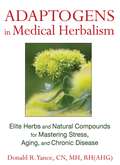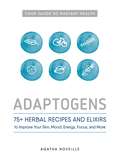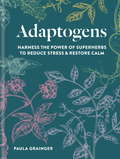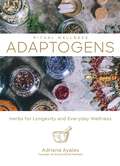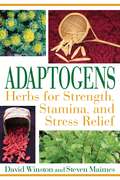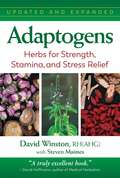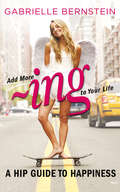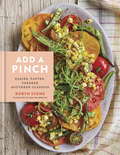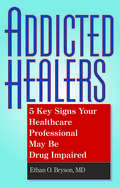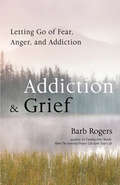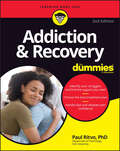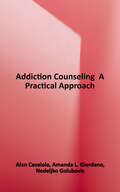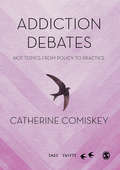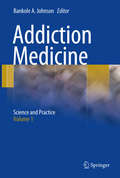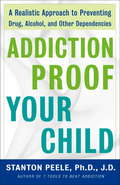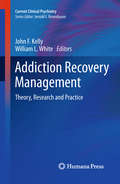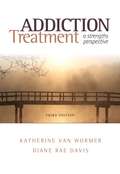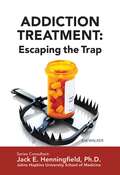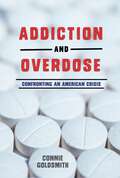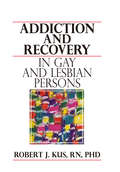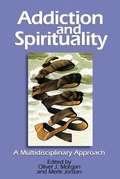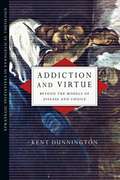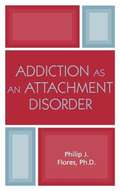- Table View
- List View
Adaptogens in Medical Herbalism: Elite Herbs and Natural Compounds for Mastering Stress, Aging, and Chronic Disease
by Donald R. YanceA scientifically based herbal and nutritional program to master stress, improve energy, prevent degenerative disease, and age gracefully • Explains how adaptogenic herbs work at the cellular level to enhance energy production and subdue the pro-inflammatory state behind degenerative disease • Explores the author’s custom adaptogenic blends for the immune system, cardiovascular health, thyroid function, brain health, and cancer treatment support • Provides more than 60 monographs on herbs and nutritional compounds based on more than 25 years of clinical practice with thousands of patients Weaving together the ancient wisdom of herbalism and the most up-to-date scientific research on cancer, aging, and nutrition, renowned medical herbalist and clinical nutritionist Donald Yance reveals how to master stress, improve energy levels, prevent degenerative disease, and age gracefully with the elite herbs known as adaptogens. Yance’s holistic approach, called the Eclectic Triphasic Medical System (ETMS), is based on extensive scientific research, more than 25 years of clinical practice, and excellent results with thousands of patients. It centers on four interconnected groups of health tools: botanical formulations, nutritional supplements, diet, and lifestyle. Defining three categories for adaptogenic herbs, he explains how formulations should combine herbs from each category to create a synergistic effect. He provides more than 60 monographs on herbs and nutritional compounds as well as custom combinations to revitalize the immune system, build cardiovascular health, protect brain function, manage weight, and support cancer treatment. He explains the interplay of endocrine health, the hypothalamic-pituitary-adrenal (HPA) axis, thyroid function, and stress in the aging process and reveals how adaptogenic treatment begins at the cellular level with the mitochondria--the microscopic energy producers present in every living cell. Emphasizing spirituality, exercise, and diet in addition to herbal treatments and nutritional supplements, Yance’s complete lifestyle program explores how to enhance energy production in the body and subdue the proinflammatory state that lays the groundwork for nearly every degenerative disease, taking you from merely surviving to thriving.
Adaptogens: 75+ Herbal Recipes and Elixirs to Improve Your Skin, Mood, Energy, Focus, and More
by Agatha NoveilleHarness the power of herbs to boost resilience, stamina, and brain function! Adaptogens are a unique class of herbs that greatly improve your body's reaction to emotional and physical stress while increasing your energy, stamina, endurance, and mental clarity. Recent studies support what practitioners of Indian Ayurveda and traditional Chinese medicine have known for centuries--these herbs including Rhodiola, ginseng, licorice, and more--and have positive benefits on wellness and are safe for long-term use. Whether you're interested in honing your mental abilities to a razor-sharp level, want to give your athleticism a boost, or are looking for ways to improve your healthy lifestyle, adaptogens have so much to offer for everyday well-being. In Adaptogens, popular wellness blogger and herbalist Agatha Noveille reveals the secrets to vibrant health and natural healing--without the use of conventional drugs. Inside, you'll learn about the health and wellness benefits of twenty-three adaptogenic herbs, including Rhodiola, Ashwagandha, Maca, He Shou Wu, and Holy Basil. You'll also find more than 75 recipes for potions and remedies to improve sleep, mood, mental focus, immune function, stamina, and for general wellness and beauty. These all-natural, safe remedies fight the effects of chronic stress, while restoring your body's balance, health, and vitality.
Adaptogens: 75+ Herbal Recipes and Elixirs to Improve Your Skin, Mood, Energy, Focus, and More
by Agatha NoveilleHarness the power of herbs to boost resilience, stamina, and brain function! Adaptogens are a unique class of herbs that greatly improve your body's reaction to emotional and physical stress while increasing your energy, stamina, endurance, and mental clarity. Recent studies support what practitioners of Indian Ayurveda and traditional Chinese medicine have known for centuries--these herbs including Rhodiola, ginseng, licorice, and more--and have positive benefits on wellness and are safe for long-term use. Whether you're interested in honing your mental abilities to a razor-sharp level, want to give your athleticism a boost, or are looking for ways to improve your healthy lifestyle, adaptogens have so much to offer for everyday well-being. In Adaptogens, popular wellness blogger and herbalist Agatha Noveille reveals the secrets to vibrant health and natural healing--without the use of conventional drugs. Inside, you'll learn about the health and wellness benefits of twenty-three adaptogenic herbs, including Rhodiola, Ashwagandha, Maca, He Shou Wu, and Holy Basil. You'll also find more than 75 recipes for potions and remedies to improve sleep, mood, mental focus, immune function, stamina, and for general wellness and beauty. These all-natural, safe remedies fight the effects of chronic stress, while restoring your body’s balance, health, and vitality.
Adaptogens: Harness the power of superherbs to reduce stress & restore calm
by Paula GraingerIncreasing numbers of people are suffering from stress, anxiety and fatigue caused by lack of sleep, digital overload and our 24/7 lifestyle. In Adaptogens, Medical Herbalist Paula Grainger provides an answer to this modern-day affliction by introducing us to the group of powerful herbal ingredients known as adaptogens..Adaptogens, such as Ashwagandha, Maca, Korean ginseng, Turmeric, Reishi mushrooms, Liquorice, Rosemary and Rhodiola, have been scientifically proven to lower levels of the stress hormone cortisol and prevent adrenal imbalances that can lead to adrenal fatigue and 'burn-out'. Delve into the history and science of these miraculous plants and learn how to maximize wellness using the most easy-to-source adaptogens, incorporating them into your life via delicious smoothies, energy bites and desserts, invigorating teas, tonics and lattes, and wonderful beauty elixirs.
Adaptogens: Harness the power of superherbs to reduce stress & restore calm
by Paula GraingerIncreasing numbers of people are suffering from stress, anxiety and fatigue caused by lack of sleep, digital overload and our 24/7 lifestyle. In Adaptogens, Medical Herbalist Paula Grainger provides an answer to this modern-day affliction by introducing us to the group of powerful herbal ingredients known as adaptogens..Adaptogens, such as Ashwagandha, Maca, Korean ginseng, Turmeric, Reishi mushrooms, Liquorice, Rosemary and Rhodiola, have been scientifically proven to lower levels of the stress hormone cortisol and prevent adrenal imbalances that can lead to adrenal fatigue and 'burn-out'. Delve into the history and science of these miraculous plants and learn how to maximize wellness using the most easy-to-source adaptogens, incorporating them into your life via delicious smoothies, energy bites and desserts, invigorating teas, tonics and lattes, and wonderful beauty elixirs.
Adaptogens: Herbs for Longevity and Everyday Wellness (Ritual Wellness #1)
by Adriana AyalesA renowned practitioner of herbal medicine offers a beautiful introduction to adaptogenic herbs, explaining what they are, how they improve your life, and how you can use them for personal wellness. Adaptogenic herbs—like ginseng, cordyceps, and rhodiola—work to counteract the effects of stresses on the body. Used for millennia in Eastern healing, they have now become popular again. Adriana Ayales, owner of Anima Mundi Herbals, shares her in-depth knowledge of these amazing herbs. In addition to a list of complementary herbs that pair wells with adaptogens, Ayales also lists &“master herbs&” being researched for their adaptogenic-like chemistry. She offers 30 recipes for food, drinks, and natural beauty cures that can help banish fatigue, sharpen your mind, stimulate your central nervous system, and enhance vitality. Beautifully illustrated throughout, this authoritative guide also provides daily self-care tips for promoting wellness in mind, body, and spirit.From ginseng to cordyceps to rhodiola, centuries-old adaptogens are popular again. The core essence of these widely available herbs is that they are masterful longevity tonics, popularly known for their ability to protect against the negative effects of stress. In this beautifully illustrated book, Adriana Ayales, founder of Anima Mundi Herbals, shares must-know information on adaptogens and secondary adaptogens. You&’ll also find everyday self-care recipes, from warming tonics and lattes to foods like smoothie bowls, to cocktails and spritzers, as well as bath and body products. With this book at hand, you can navigate the amazing world of adaptogens.
Adaptogens: Herbs for Strength, Stamina, and Stress Relief
by David Winston Steven MaimesThe definitive guide to adaptogenic herbs, formerly known as “tonics,” that counter the effects of age and stress on the body • Reveals how adaptogens increase the body’s resistance to adverse influences • Provides a history of the use of these herbal remedies and the actions, properties, preparation, and dosage for each herb We all deal with stress every day, and every day our bodies strive to adapt and stay balanced and healthy. In Adaptogens, authors David Winston and Steven Maimes provide a comprehensive look into adaptogens, non-toxic herbs such as ginseng, eleuthero, and licorice, that produce a defensive response to stress in our bodies. Formerly known as rejuvenating herbs or tonics, adaptogens help the body to “adapt” to the many influences it encounters. They increase stamina and counter the normal effects of aging and thus are becoming important tools in sports medicine and in the prevention and treatment of chronic fatigue and other stress-related disorders. Winston and Maimes present the historical uses of these herbal remedies in India, Russia, China, and the Americas and explain how they work and why they are so effective at combating stress-induced illness. Monographs for each adaptogen also present the latest scientific research and include the origin, traditional use, actions, properties, preparation, and dosage for each herb.
Adaptogens: Herbs for Strength, Stamina, and Stress Relief
by David WinstonAn updated and expanded edition of the definitive guide to adaptogenic herbs • Includes a Materia Medica with monographs covering 25 adaptogens, including eleuthero, ginseng, rhodiola, schisandra, ashwagandha, licorice, shatavari, reishi, and holy basil, as well as complementary nervines, restorative tonics, and nootropics • Explains how adaptogens increase the body’s resistance to adverse influences, increase energy and stamina, and counter the effects of age and stress on the body • Details the actions, properties, preparation, and dosage for each herb and their uses in Ayurveda and Chinese medicine and as remedies for animals Every day our bodies strive to adapt and stay balanced, energized, and healthy, yet chronic stress and the resulting elevation of stress hormones such as cortisol have been shown to be major factors behind not only fatigue and weight gain but also many chronic and degenerative diseases. In this updated edition of the definitive guide to adaptogenic herbs, clinical herbalist David Winston and researcher Steven Maimes provide a comprehensive look at adaptogens: non-toxic herbs such as ginseng, eleuthero, and ashwagandha that help the body “adapt” to the many influences it encounters and manage the stresses it experiences. They also increase stamina and energy, boost cognitive function, restore the immune system, and counter the effects of aging, especially when used in appropriate combinations. Beginning with a history of the use of adaptogens, including in Ayurveda, Chinese medicine, and Russian medicine, the book examines how these herbal remedies work and why they are so effective at combating stress-induced illness and ailments. The extensive Materia Medica includes monographs on 25 adaptogens, including eleuthero, ginseng, rhodiola, schisandra, ashwagandha, shatavari, reishi, and holy basil, as well as complementary nervines, restorative tonics, and nootropic herbs, such as milky oats, astragalus, St. John’s wort, and ginkgo. Each monograph presents the latest scientific research and details the origin, traditional and clinical uses, actions, properties, preparation, and dosage for each herb. The book also includes guidance on adaptogenic remedies for our animal companions. Aimed not only at herbalists but also those interested in natural health, this guide to adaptogens will allow you to safely and effectively use these herbal remedies to enhance your health and improve your chances of living a longer, healthier, and well-balanced life.
Add More -Ing to Your Life: A Hip Guide To Happiness
by Gabrielle BernsteinLots of people are selling happiness these days as if it were a marketable commodity. But in her hip self-transformation book, Add More ~ing to Your Life, motivational speaker and life coach Gabrielle Bernstein truly shows you how to make happiness a way of life. Ms Bernstein is bringing happy back.Designed to bulldoze negative thought patterns and create personal change through positive affirmations, physical activity and visualisation meditations, Gabrielle guides the reader to happiness in 30 days through her dynamic ~ing, a proven method of sharpening one's intuitive senses and activating untapped inspirations. Gabrielle will prepare you to change your life by accessing a state of flow, helping you connect with your ~ing, your inner guide, and readying you to release your limiting beliefs and to choose happiness.
Add a Pinch: Easier, Faster, Fresher Southern Classics
by Ree Drummond Robyn StoneWith a foreword by Ree Drummond, this beautiful book has 100 easier, faster, lightened-up Southern recipes, from the blogger behind the popular Add a Pinch website.
Addicted Healers
by Ethan O. BrysonPrescription drug abuse represents a serious and growing public health problem in the medical profession. We the public have a right to know what we are getting into when we walk through the doors of a hospital or doctor's office.One to two percent of all healthcare professionals will become addicted each year. This figure is rough, since not every addicted healthcare professional overdoses, gets caught or ends up in a treatment program or before the state medical or nursing board for disciplinary action. If they do enter treatment they may do so anonymously or not through a referral from a state agency. Because of these issues, the prevalence of addiction in the population of healthcare professionals remains unknown."Addiction is a disease of isolation," states Bryson. It is rare that the addicted healthcare professional has the luxury of a confidant. If they are discovered, they fear they will lose their jobs, their licenses and the ability to find another job, as well as the respect of former colleagues, family
Addiction & Grief: Letting Go of Fear, Anger, and Addiction
by Barb RogersEmotional Recovery From AddictionAuthentic recovery is more than an attitude. It is based on emotional work that involves an honest appraisal of one's life. It is through dealing with unresolved feelings of grief and anger that one can truly heal from addiction.The emotional “bottom” of recovery. Just as one needs to hit bottom with drinking or using in order to begin recovery, eventually one will also hit an emotional “bottom” of fear, anger, and grief. And recovery can only start by first understanding how, when, and where those emotions took control. Author Barb Rogers challenges readers in recovery to investigate the unresolved grief and loss in their lives and helps readers navigate the impacts of those emotions—emotions that can lead back to using if not resolved.Finding healing and happiness. Recovery from addictions involves more than getting sober. It involves finding happiness, which can only happen if the emotional work is done as well. Negative emotions have the ability to weigh on us and influence both our decisions and the way we handle life’s challenges. If we continue to live with fear, anger, and grief, we aren’t really free from our addictions. The steps to recovery—authentic and complete recovery—involve healing from the deeper issues in our life. Learn more about:The emotional healing that goes hand-in-hand with addiction recoveryDealing with grief and resolving underlying issuesHow to find happiness after getting soberIf you learned from books like This Naked Mind, Rewired, The Mindfulness Workbook for Addiction, or A Gentle Path Through the Twelve Steps, then you’ll want to read Addiction & Grief.
Addiction & Recovery For Dummies
by Paul RitvoNo matter what your road to recovery looks like, Dummies is on your side Addiction and Recovery For Dummies gives you the tools you need to identify and face addiction in yourself or a loved one, while working towards a healthy and realistic approach to recovery. This book offers a compassionate, unbiased, and non-judgmental guide to evaluating and overcoming addiction. You’ll learn to identify the range of addiction levels, the various types (including substance and non-substance), and the possible causes of addiction. An expert author guides you through the range of addiction treatment philosophies and approaches, including twelve-step programs, other in- and outpatient programs, and teen treatments. We’ll also look at common recovery roadblocks, so you’re prepared to overcome whatever hurdles your recovery process brings. Medications, therapeutic communities, self-help groups, long-term recovery strategies—it’s all in here. Learn the signs of addiction and identify the most appropriate treatments Gain advice on offering help to friends or family members struggling with addiction Discover available recovery supports, including groups and medications Understand the media and cultural factors that encourage addiction, and how to avoid themUpdated with the latest treatment options, Addiction & Recovery For Dummies is a valuable resource for those on a recovery journey, and a support guide for the 45 million people who are directly impacted by addiction.
Addiction Counseling: A Practical Approach
by Alan Cavaiola Amanda L. Giordano Nedeljko GolubovicEquips the upcoming generation of counselors with crucial knowledge to skillfully treat both chemical and behavioral addictions <p><p>Grounded in leading-edge, evidence-based research, this hands-on text applies a step-by-step approach to addictions counseling. This book encompasses assessment, diagnosis, and treatment planning; case management; and relapse prevention, with an incisive focus on behavioral addictions and co-occurring disorders. The text covers all essential topics as outlined in the gold standard SAMSHA Counselor Training Manual. Included are detailed guidelines on how to write succinct treatment plans and conduct effective client sessions; case studies; role-playing exercises; and clinical applications to assessment and diagnosis, treatment planning, and case management. Notes from the Field" provides actual interviews with experienced clinicians working with a variety of client populations throughout the country. <p><p>Critical topics unique to the book include the role of neuroscience in addiction treatment, relapse prevention, and advocacy. In addition, the text offers specific chapters on behavioral addictions and co-occuring disorders as well as a separate chapter on multicultural counseling covering gender, racial, ethnic, sexual orientation, age, religion, and disability considerations. It is also distinguished by an abundance of downloadable forms and documents. Pedagogical elements to help learners process and apply concepts include learning objectives, terms to know, learning activities, recommended resources, and chapter summaries. Faculty aids include an instructor's manual with sample syllabi, CACREP mapping tools, test bank, and PowerPoint slides. This essential resource will be valued as a primary textbook for any course that focuses on addiction counseling and treatment. <p><p>Key Features: <p>•Describes a variety of etiological models and how they become a means of assessing biopsychosocial risk factors <p>•Delivers step-by-step guidelines on how to write concise treatment plans and for conducting effective treatment sessions <p>•Devotes a chapter to motivational interviewing to promote willingness to change <p>•Includes cutting-edge research pertaining to neuroscience and its applications and evidence-based treatment practices <p>•Provides separate chapter on multicultural counseling and substance use disorders among people of diverse races, ethnicities, genders, class, ages, and spirituality <p>•Offers real-world insights with "Notes from the Field" feature <p>•Facilitates practical application through role play exercises, treatment technique and assessment case examples, biopsychosocial assessment guidelines, how to provide client feedback, and more <p>•Includes multiple digital downloadable tools and purchase includes digital access for use on most mobile devices or computers
Addiction Debates: Hot Topics from Policy to Practice (SAGE Swifts)
by Catherine ComiskeyAddiction Debates explores the tumultuous landscape of addiction research, policy and practice. Covering all the ′hot topics′ of the day in a balanced and informative manner, Comiskey provides international perspectives on each topic, stimulating debate and discussion via the different approaches taken globally. Considering the complexities of debates around legalisation, rehabilitation, abstinence, harm reduction, and the current opioid epidemic, this SAGE Swift also looks into the health and social concerns related to drug consumption. Less-often debated topics include the ageing population of people who use drugs, the rights of the child of parents who use drugs, and the pressure these unique factors put on public health and associated services. A relevant text for a range of disciplines and people, sure to inform, challenge and continue the debate.
Addiction Medicine: Science and Practice
by Bankole A. JohnsonThe spectrum of addiction disorders presents practitioners with numerous challenges--among them the widening gap between a growing evidence base and the translation of this knowledge into treatment outcomes. Addiction Medicine addresses this disconnect, clearly explaining the role of brain function in drug taking and other habit-forming behaviors, and applying this biobehavioral framework to the delivery of evidence-based treatment. Its state-of-the-art coverage provides clinically relevant details on not only traditional sources of addiction such as cocaine, opiates, and alcohol, but also more recently recognized substances of abuse (e.g., steroids, inhalants) as well as behavioral addictions (e.g., binge eating, compulsive gambling, hoarding). Current behavioral and medical therapies are discussed in depth, and the book's close attention to social context gives readers an added lens for personalizing treatment. An international panel of expert contributors offers the most up-to-date information on: Diagnosis and classification Neurobiological and molecular theories of addiction Behavioral concepts of addiction Clinical aspects of addiction to a wide range of substances, including opiates, stimulants, sedatives, hallucinogens, alcohol, nicotine, and caffeine Science-based treatment options: pharmacotherapy, pharmacogenetics, potential vaccines, brief and compliance-enhancing interventions, cognitive behavioral treatment, behavioral management, and other psychosocial interventions Behavioral addictions--including compulsive eating, Internet messaging, and hypersexuality--and their treatment Addiction in specific populations, including adolescents, the elderly, pregnant women, and health care professionals Legal, disability, and rehabilitation issues At once comprehensive and integrative, Addiction Medicine is an essential text and a practice-expanding tool for psychiatrists, health psychologists, pharmacologists, social workers, drug counselors, trainees, and general physicians/family practitioners.
Addiction Proof Your Child: A Realistic Approach to Preventing Drug, Alcohol, and Other Dependencies
by Stanton PeeleIn a world where binge drinking, recreational and prescription drug abuse, chronic overeating and anorexia, and Internet gambling and pornography are all too common among teens, it's time to rethink the conventional wisdom about addiction. We clearly need something more than "just say no. " This book is the alternative.
Addiction Recovery Management: Theory, Research and Practice (Current Clinical Psychiatry)
by John F. Kelly William L. WhiteAddiction Recovery Management: Theory, Research, and Practice is the first book on the recovery management approach to addiction treatment and post-treatment support services. Distinctive in combining theory, research, and practice within the same text, this ground-breaking title includes authors who are the major theoreticians, researchers, systems administrators, clinicians and recovery advocates who have developed the model. State-of-the art and the definitive text on the topic, Addiction Recovery Management: Theory, Research, and Practice is mandatory reading for clinicians and all professionals who work with patients in recovery or who are interested in the field.
Addiction Treatment: A Strengths Perspective (Third Edition)
by Diane Rae Davis Katherine Van WormerThis book covers the biological, psychological, and social aspects of alcoholism, eating disorders, compulsive gambling, and other addictions.
Addiction Treatment: Escaping the Trap (Illicit and Misused Drugs)
by Ida WalkerIn the United States and Canada, millions of individuals have problems with substance abuse. In some cases the problems are relatively minor, but in others, that abuse leads to addiction. Addiction is a serious and costly disease. In Addiction Treatment: Escaping the Trap, you will learn some definitions important in the study of addiction treatment. You will also learn about the history of addiction treatment, including the work and continuing influence of the Washingtonians, the Emmanuel Movement, the Oxford Movement, and of course, Alcoholics Anonymous. Treatment philosophies are also presented in this book Not all treatment methods are alike, and successful addiction treatment combines a variety of approaches. In Addiction Treatment, you will learn that recovery is an ongoing process, and read about suggestions on how to maintain a sober life.
Addiction and Overdose: Confronting an American Crisis
by Connie GoldsmithDrug overdosing and death from prescription painkillers and heroin are at epidemic levels in the United States. How do people become addicted to opioids and other dangerous drugs, and why? Meet the experts who study the neurology of addiction. Hear stories of addicts in recovery, and of loved ones left behind by those who died from overdosing. Discover more about the social and economic costs of overdosing and learn about scientific research to decrease it. Learn about the connection between addiction and mental health disorders. Find out how to identify signs of addiction and overdose and what you can do to help someone get assistance.
Addiction and Recovery in Gay and Lesbian Persons
by Robert J KusThis book provides chemical dependency clinicians a sampling of the work being done in the fields of gay and lesbian chemical dependency to enable clinicians to provide better care for their gay and lesbian clients.After an overview of 7 research studies which examine the incidence of alcoholism and/or chemical dependency in gay and lesbian persons, the contributing authors explore the special concerns of recovering gay and lesbian addicts.Chapters focus not only on issues in the fields of gay and lesbian chemical dependency but how clinicians can use this knowledge to better care for their gay and lesbian clients. Readers will find new information on: working with HIV positive persons homophobia as a critical root in chemically dependent gays and lesbians positive changes for dysfunctional relationships common with gays and lesbians spirituality in gay and lesbian communities the special needs of the rural gay/lesbian client gay men&’s groups in AA a retrospective of NALGAP resources and referrals for chemically dependent gay and lesbian personsAddiction and Recovery in Gay and Lesbian Persons assists social workers and other helping professionals working with chemically dependent clients learn more about how to adequately treat them. Gay and lesbian persons recovering from a chemical addiction will also find this book enlightening.
Addiction and Spirituality
by Oliver J. Morgan Merle R. JordanReligious and secular counselors from a variety of disciplines share their basic approaches in working with addicted persons and their understandings of the spiritual dimension in treatment and recovery.
Addiction and Virtue: Beyond the Models of Disease and Choice
by Kent J. DunningtonWhat is addiction? Neither of the current dominant models (disease or choice) adequately accounts for the experience of those who are addicted or of those who are seeking to help them.
Addiction as an Attachment Disorder
by Philip J. FloresFrom the Foreword: "Addiction is a disorder in self-regulation. Individuals who become dependent on addictive substances cannot regulate their emotions, self-care, self-esteem, and relationships. In this monumental and illuminating text Philip Flores covers all the reasons why this is so. But it is the domain of interpersonal relations that he makes clear why individuals susceptible to substance use disorders (SUDs) are especially vulnerable. His emphasis on addiction as an attachment disorder is principally important because he provides extensive scholarly and clinical insights as to why certain vulnerable individuals so desperately need to substitute chemical solutions and connections for human ones. The strength of Flores's paradigm of addiction as an attachment disorder is that it is a theory that effectively and wisely guides treatment, but at the same time, when properly implemented or practiced, the treatment resonates with and further enhances the theory. Flores's work here is an extraordinary one because, in parsimonious and clear language, he makes a major contribution to the literature and practice of effective psychotherapy in general and effective psychotherapy for the addictions in particular. He fills in all the gaps between theory and practice covering wide and ranging issues of what practice and empirical findings have to teach about the critical ingredients of AA, group therapy, and individual psychotherapy. This is a job well done because it helps students and experienced clinicians alike to always be mindful of how they bring their humanity to the distress and suffering of others. His theory of addiction as an attachment disorder makes it particularly clear how especially important this is for those suffering with addictive disorders. " —Edward J. Khantzian, M.D., clinical professor of psychiatry, Harvard Medical School
